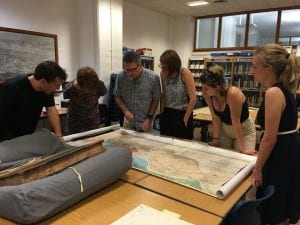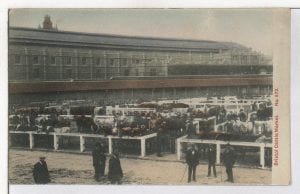 I looked at changes in both legislation and public opinion around cattle markets in the nineteenth century, spurred by protests against the treatment of animals at Smithfield market in London. Working with members of the History and Veterinary departments at the University, an interdisciplinary approach has helped to uncover fascinating details of the experience of animals in the market and their treatment on journeys to and from the Temple Meads site.
I looked at changes in both legislation and public opinion around cattle markets in the nineteenth century, spurred by protests against the treatment of animals at Smithfield market in London. Working with members of the History and Veterinary departments at the University, an interdisciplinary approach has helped to uncover fascinating details of the experience of animals in the market and their treatment on journeys to and from the Temple Meads site.
Bristol Cattle Market initially held market day on Thursdays, with an additional opening on Mondays added later due to high demand. With numbers in the thousands at full capacity, the market held a range of livestock, including cows, calves, sheep, pigs and horses. The establishment of the Great Western Railway station at Temple Meads in 1840 increased the ease of access to the market, both for consumers and animals. Cattle travelled to the market on foot from local farms, by rail from the surrounding areas, and by boat from Ireland and Canada. The journey by boat in particular was reported to have been long and strenuous for the animals, with the minimum amount of food, water and physical space provided in efforts to keep costs low.
Bristol Cattle Market was nevertheless seen by many as the model of good practice in animal welfare, particularly in comparison to Smithfield. In Bristol, drovers – who walked the animals into the city – did not use the sharpened sticks commonly known as ‘goads’ to herd the cows. The location of the Market itself also ensured that the pens were of regulation size and there was less overcrowding in Bristol than at other major city markets, especially Smithfield. However the extent of animal welfare provision in the market should not be exaggerated. Butchers’ reports noted bruising and cuts on slaughtered animals, and a number of contemporaries observed unnecessary cruelty to cattle on the part of the drovers. One resident of St Phillip’s Marsh recalled her terror of market day as a child:
It was terrifying to hear the herdsmen shouting and hitting those maddened cows, and the Bulls had rings through their noses with men pulling them along on huge ropes. Blood would be running down from their faces where the rings had cut into their nostrils. Sometimes men would put a sack over the Bulls heads to quieten them down. Once a Bull put his backside against my Aunties front door and broke it down, and then one of the cows ran into the house.
Source: St Philips Marsh, The Story of an Island and its People, BRO Pamphlet/2054. P39
Through the nineteenth century, public awareness of animal cruelty was on the increase , exemplified by the establishment of the Society for the Prevention of Cruelty to Animals (now the RSPCA) in 1824. The Bristol branch of the society was established in 1842, and funded regular inspections of the market, increasing the number of cruelty cases brought to court. Contemporary newspapers frequently reported the details of such cases, with cases commonly involving the binding of calves mouths with twine, which became ‘quite sunk into the flesh’, to prevent the calves from suckling and the exposure of diseased animals in the market.
Source: The Bristol Daily Post, Monday February 11 1861
The Market allowed the city to grow, putting Bristol on the map as having a good market for space for the animals and closeness to a train line. The significance of the market, and it’s long history, should be reflected in the new development of the University to commemorate the lives of the people and animals who dedicated their lives to it. We hope the essence of the market can be understood for the importance it held for Bristol, and for feeding all those who benefited from it. I have thoroughly enjoyed working on this project, and would like to thank the Brigstow Institute and the Temple Quarter group for their help and support. I hope you enjoy this film about our project and the history of the Temple Quarter Enterprise Campus.


